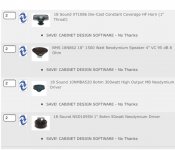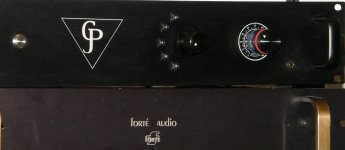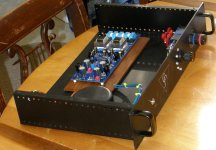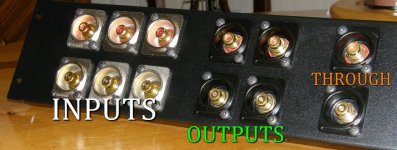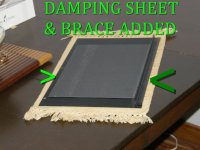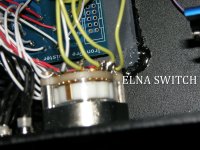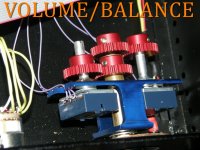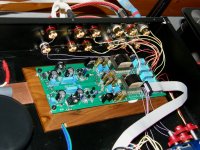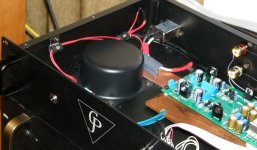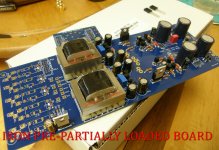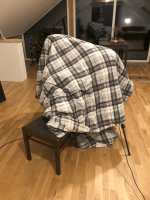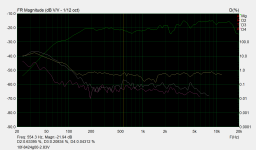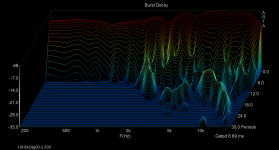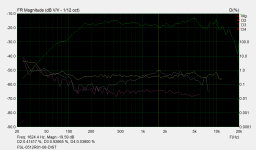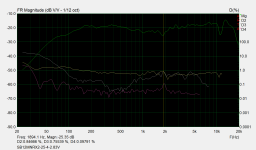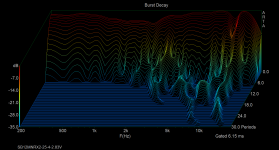I've been a "Cedar Artist" as I refer to myself, for 14 years now. Specializing in Cedar art furniture primarily for Gatlinburg/Pigeon Forge TN cabin rentals and residential homes in the area too. (relative to the question and topic) and this time and experience has intertwined with my other hobby , since 1985, I've been an audio hobbyist and cabinet designer /builder. When I moved to TN and discovered the "regional specific" eastern red cedar, as it grows only in certain states, and while related to typical and more common western cedar, I've not truly found any specific studies compiled of data or results of anyone's experiments on the acoustics of the cedar as a whole, or in the "red heart wood inner wood" or using "only the white exterior pulp wood" as opposed, being that most everyone focuses on the red portion, of any cedar, leaving the softwood white out completely. The red in er heart wood has a harder, more crisp strength to it, but the white portion when properly dried, has a lighter "non sappy" appeal so much that I cut out my largest portions of it, and with some being over 8" to 12" by 6 feet, there is more than enough for me to do some trials.
Now, I am aware that many of you with build experience may or will say that no matter what, eastern or not, red or white, it's not acoustical wood for audio cabinets. And I humbly inquire the results of the tests you've collected, specifically on both and each, and the different things conducted in efforts to obtain best results. And if you haven't, please hear me out. Because I have recently conducted many, on both and each color, and with varying thickness and with/without assorted wood conditioners and resins for adding strength and resonance, for adding or taking the varied hardness of "limbknots" where for example, a cabinet side with several of them has an equivalency of many hardwoods density, and a side without any has a very different result. Good or not depending on your desired resonance and acoustical properties.
So, my new friends, I ask 1 thing before you pass any "too negative or dismissive objections" , that you please allow the possibility that with proper preparation, and specifics that I've given to the wide variety of testing, and conditioning, that it could very well be a " not better, not worse, but different" kind of very good, and highly acoustical advantage in acquiring specific and in general great sounding cabinets. If , like myself, the many people who desire, and in my case, truly enjoy the look of that "Wild-Fire" reds, oranges, tan, and whites of true eastern cedar boards when using the whole board of a cut tree. And even a cabinet with sides having solid white to red and back to white. Cured to a moisture content specific, with exact thickness tests and all. I know about birch, MDF and standard plywood. Who don't. But what if I gave you some samples, and see for yourself if you build, and if you don't, then at least let your ears hear a live , real demonstration not altered by phone or PC mics and speakers not allowing for the true quality to be known like you get with a live listening session. I'm not out to sell anything to you, other than sell the possibility that there may actually be someone out here that took the time most don't have to thoroughly test a multitude of samples of the wood in enough ways to definitively say, every reasonable way this wood can be tested to be absolutely sure if it's abilities or restrictions are known for any and all acoustic characteristics it can possess , is done. And I do welcome all builders and members comments, and just an idea, let's be nice, friends are always in short supply who are open and transparent with hard and long toiled hours spent to just give away the results , only to get heckled by "Yondoodle Pigglybuck" from whothcares Idaho when their knowledge of anything cabinet-wise comes from something like :Snoop Dogs book :"Yo Yo Yo You can bild-da-dopest car box! Vershizel!! , (and other projects while you burn a Doobie" )
Lol. But seriously, I've built 6 sets of cabinets, mainly for my customers who have a cabin full of cedar furniture and wanted their stereo cabinets to match. Naturally my very first few were a thin laminate of cedar overlaid on a nice but common cabinet as customer expected. But when I was asked to rebuild an entire acoustic piano, by removing it's wood from harp, and replacing every piece with cedar, so he would have the first ever eastern red cedar piano, at least to date, I've never seen one anywhere till mine. , but possibly could exist I got the notion to do my own cabs in the wood I live, but will only pursue " if" my tests prove it's a viable option if the sound came close or equal to a moderate to upper end (and possibly better) sound quality, even if I try out 1000 experiments and tests, plus, get the opinions of more audio enthusiasts.
This is where any of you come in to play, if interested and not to far away from Mooresburg TN, near Morristown TN, and Knoxville, Sevierville area, ect. My workshop/studio is open to anyone willing to stop by, and if you can't, I certainly would let anyone "borrow" a single small speaker "if" they want it shipped , they pay that cost, but absolutely not a sale, as there is no cost to you trying it out and fill out an opinion and idea letter and just mail the letter with ideas or opinion on it to me. After all, my ears hear one sound and yours may hear it better or not. But it's only YOUR opinions, the audiophiles, that can't best determine this. (My wife humms happily to a mono 4" old crackled speaker that is all the way left and the tone adjustment is her big " fine tuning the sound good like". Lol. So ya, great woman, lousy opinion on audio. She literally learned that speakers have " magnetic properties " when she got with me. So .. ya.. need anyone local and if interested and your not local, I'd love to send ya a free small example, now it's about the cabinets wood, so ill send a small cabinet, and you'd just need to put whatever drivers you have in it, and hopefully use only better drivers than cheap. Yes I do know drivers are matched to the cabinets, and it's a mated pair that's best, but, I can't send free cabinet AND drivers that obviously makes shipping heavier. And I'll provide the optimal range of driver specs to best test it. I AM NOT OUT AFTER Anyone's ADDRESSES ! P. O. Boxes, business address is fine, I am not a shyster, or whatever. Lol. God, after a post like this, if I were, sheesh, a bit overkill for a con man isn't it? I only want honest opinions and options for improvement "if" any. But I have a lot of confidence in its above the norm or expected level of results.
And if none are interested here, no problem, I'll still get my local opinions and let ya know the results. And when I can, I'll post pics of these beauties. Tha ja for your ear, your time, and hopefully, your "nice" responses. But there's always 1, (or5) in every bunch right? Lol
James B.
